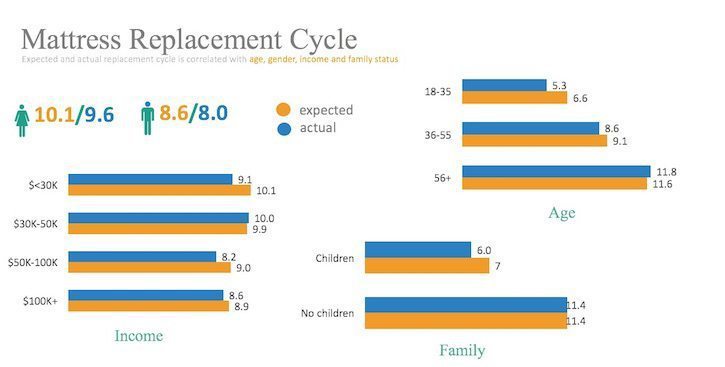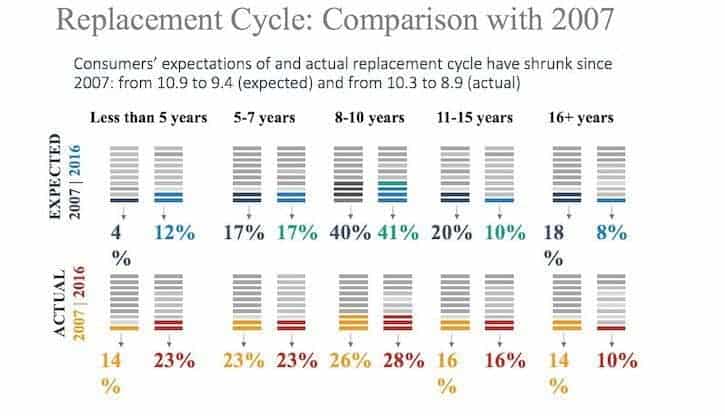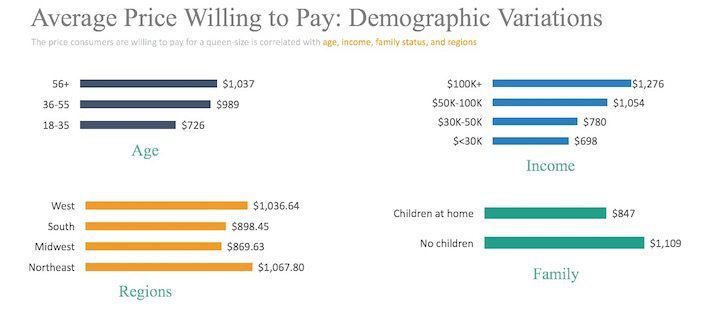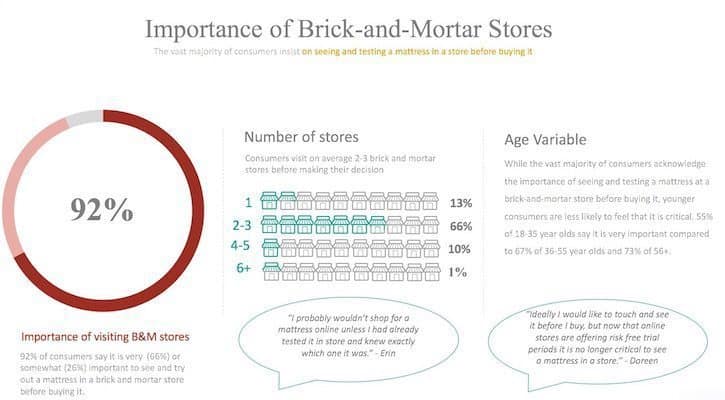Exclusive Better Sleep Council Research
A 2016 study from the Better Sleep Council, the consumer-education arm of the International Sleep Products Association, on what motivates today’s mattress shoppers reveals changes in bedding-shopping behavior, including shorter replacement cycles, an expectation of higher ticket prices and the influence of technological trends on research and purchasing habits
For the first time, consumers’ expectations for how long a mattress should last have dropped below 10 years. Let’s repeat that: Consumers no longer presume their mattress will last more than a decade. Or put it this way: Getting a new mattress, in the minds of most consumers, is no longer on the same schedule as getting a tetanus booster—and is just as important to their health.
This is a big deal.
A shorter mattress replacement cycle means consumers can take better advantage of new component technologies and advancements in construction techniques. They can benefit by enjoying mattresses that offer different levels of comfort and support as their bodies change and age. It’s also nice for the mattress industry, which can introduce innovations to consumers more rapidly.
According to the latest research conducted on behalf of the Better Sleep Council, the consumer-education arm of the International Sleep Products Association, consumers now expect to keep a new mattress, on average, for 9.4 years—a drop of about 1½ years from the 10.9 years cited by consumers the last time such research was done in 2007.
Another big deal: The 2016 research has found that consumers expect a new mattress to cost more, on average they say, $1,110—a significantly higher price point than consumers reported in the past.
“Since the last wave of research was done in 2007, significant economic, technological and societal trends have redefined the way we shop and relate to brands,” writes Fluent Research, which conducted the research, in a report accompanying the 2016 results. “In the current study, we address how these trends—such as the emergence of millennials, the rise of social media and the technological advances in the mattress industry—have impacted consumers’ relationship to sleep and mattresses.”
Turn, turn, turn: The mattress replacement cycle speeds up

Expected: How many years would you expect to keep a new mattress? (N=2000) | Actual: How many years did you have your previous mattress before you replaced it with the one you currently sleep on? (N=2000)
As we said, for the first time since the BSC started carrying out significant, periodic qualitative and quantitative consumer research in 1996, consumers’ expectations for how long a mattress should last have dropped below 10 years to 9.4 years.
Even better: The actual mattress replacement cycle is compressing, too—consumers are shopping for and investing in new mattresses more often. In 2007, study respondents reported keeping their last mattress 10.3 years before replacing it with their current sleep set. Today, that timeframe is down to a median of 8.9 years. In fact, nearly three-quarters of study respondents replaced their last mattress within 8.9 years—and only 10% reported keeping their bed set more than 16 years.
These changes in both expectations and actual replacement cycles come after concerted efforts by manufacturers, retailers and the BSC to educate consumers about the advantages of replacing their old mattresses more frequently. And comments from survey respondents also show the industry’s message—that the best indicator of when to replace a mattress isn’t that it hits an arbitrary major milestone birthday (15 or 20 years), but when you’ve had it for a length of time and it no longer offers a comfortable, restful night’s sleep—is getting through to people.

Expected: How many years would you expect to keep a new, quality mattress? (N=2000) | Actual: How many years did you keep your previous mattress before replacing it with the one you currently sleep on? (N=2000)
As a respondent identified as Doreen said, “One day, I mentioned to a friend I was waking up every day with a sore back. She asked how old my mattress was and when I told her it was about 10 years old, she said that was my problem. It hadn’t dawned on me till that moment that I needed a new mattress. I did research and found out my mattress was past its prime, so I bought a new one.”
The BSC encourages consumers to evaluate the condition of their sleep set—and the quality of their own sleep—every five to seven years.
The research finds interesting generational, gender-based and socioeconomic differences when it comes to how consumers view replacing their sleep sets. Most notably, younger consumers (ages 18-35) both expect to replace and actually do replace their mattresses in more compressed cycles than their older peers, perhaps because they are experiencing life changes, such as graduations, marriages, the births of children and first-home purchases, more rapidly than older consumers. Also, younger consumers, who are used to replacing products like smartphones every couple of years, may be more attuned to the need to buy consumer products more often to enjoy the benefits of new technological advancement. When asked, “How many years would you expect to keep a new quality mattress?”, those ages 18-35 responded 6.6 years, on average. In contrast, those ages 36-55 expect to keep a new mattress 9.1 years and those 56 and older say they hope to get 11.6 years out of a new bed.
Similarly, when asked, “How many years did you have your previous mattress before you replaced it with the one you currently sleep on?”, those 18-35 said 5.3 years, while those 36-55 reported 8.6 years and those 56 and older said they’d kept their last mattress 11.8 years—more than twice as long as the youngest consumers.

And women do, in fact, hold onto their mattresses longer than their male peers. According to the research, women kept their previous mattress 9.6 years, on average, before replacing it, while men slept on their mattress only 8 years before buying a new one.
Replacement-cycle expectations also vary by income level, with those earning less generally expecting beds to last longer and, in practice, holding onto theirs longer than their higher earning peers. For instance, respondents earning between $30,000 and $50,000 expect a mattress to last 9.9 years and held onto their last one for a full 10 years. But those earning $100,000 or more presume a mattress will last 8.9 years and replaced their previous one even more quickly, after just 8.6 years.
What would you pay?
More good news: Today’s consumers are pegging the cost of a new bed higher than ever. When asked in the 2016 survey, “In your opinion, how much does a new quality queen-size mattress or mattress set cost?”, respondents said, on average, $1,110—up $181 over the $929 price point cited in the 2007 survey.
Interestingly, 2016 survey respondents reported actually paying $930, on average, for their current queen-size mattress (or set) and said they’d be “willing to pay” $955 if they “were shopping for a new mattress or mattress set” today.
In good news for mattress manufacturers, nearly half (49%) of consumers say that mattresses are fairly priced in terms of the value they provide, but another 43% say mattresses are too expensive, indicating the industry still has work to do in terms of conveying the benefits of a quality mattress.
Case in point: When asked about mattress prices in a slightly different way—one that clearly ties mattresses to sleep—consumers seem to appreciate the value of a mattress more. Two-thirds of respondents said they agree with the statement: “When you consider how much time we spend sleeping, the cost of a high-quality mattress is reasonable.” Only 29% strongly disagreed.
In general, most consumers see a link between price and quality, with one in two agreeing with the statement, “In general, the more you pay for a mattress, the better the quality of the mattress.”

Willing to pay: If you were shopping for a new mattress or mattress set today, what size would you buy and what is the maximum amount you would be willing to pay for it? (Queen-size, N=638)
Comments from respondents show how they balance price concerns with other needs and desires.
“Price has to play a role in my decision because I am on a budget,” a respondent identified as Shelly says. “But I recognize that this is a purchase which is designed to last a long time so I try to plan in advance enough so that I don’t have to buy at rock-bottom prices and have some wiggle room to get the mattress I feel is the best for my husband and me.”
Another respondent, Rosanna, puts it this way: “I consider price, but it’s probably not the most important factor. I’d rather splurge on a mattress that is a little bit more expensive if it will last me longer. I usually have a price in mind before shopping, but that may be swayed depending on what I find and what I like.”
Unsurprisingly, the more money consumers make and the older they are, the more they are willing to pay for a queen-size mattress or mattress set. For example, those earning $100,000 or more say they would shell out $1,276 for a queen—nearly twice what those earning less than $30,000 a year report they want to pay, $698. Similarly, respondents 56 and older are willing to pay $1,037, but those ages 18-35 want to pay only $726.
There also are significant differences between respondents with children and those without. Respondents with no children living at home will pay $1,109 for a queen-size mattress or set, but those with kids want to pay considerably less, only $847.
A respondent identified as Erin weighed in on how having children factors into her purchasing decisions: “For our family, we really look at price, we have three small children and don’t want to splurge on a mattress for us because we would rather splurge on something for them or put money away for a vacation.”
Decisions, decisions
Thanks to the latest research, we now know how often consumers think they need to buy a new mattress and what they are willing to pay for one. But what have we learned about how they actually go about purchasing a new sleep set? Lots!
For starters, consumers are doing their homework. Although 17% of respondents report spending only one or two days researching and shopping for a mattress before making a purchase, half of consumers say they spend between three days and two weeks gathering information and looking at options before actually buying a bed.
“I would not rush into a purchase until I felt knowledgeable of the product and comfortable that it was right for me and my husband,” a respondent identified as Kelly says.
And, like many of today’s children doing their schoolwork, shoppers turn to online sources for information.
While 57% report that they “go to stores and look around” as part of their information-gathering process, they rely heavily on web-based resources, as well. When asked, “When you want to purchase a mattress, where do you usually find the information you need?”, 41% turn to internet search engines, 26% look at the Consumer Reports website (or magazine), 24% seek out retailers’ websites and 23% visit mattress manufacturers’ websites.
Less important sources of information include independent rating/review websites, advice from retail sales associates, online ads, and advice from family members and friends—all at 19%. (Respondents could choose more than one answer.)
Showing how much consumers’ mattress shopping habits have changed, only 17% now rely on TV commercials for information about mattresses and only 14% turn to newspaper ads, according to the 2016 findings.
But, everyone who works hard in the product development and design departments of mattress manufacturers will be pleased to know, consumers also are interested in product features, brands and constructions. Some 46% of consumers compare product features, 45% read consumer reviews, 41% look for information about mattress features, 38% search for details about different types of mattresses, and 33% seek information about mattress brands, according to the 2016 research.
Less important to consumers doing preshopping research are store location (30%), information about bed bases (24%) and information about warranties (23%). (Respondents could choose more than one answer.)
Now, let’s go mattress shopping
While the latest research shows consumers are increasingly comfortable researching and, in fact, buying sleep sets online, shoppers still show a strong preference for purchasing mattresses in traditional brick-and-mortar stores. In fact, 85% of respondents say if they were looking for a new mattress today, they would likely consider doing what consumers have been doing since long before the internet was invented—walk into a local store and buy it. That said, a not-insignificant 27% of respondents told Fluent Research that they would consider making their next mattress purchase online, either through an online-only retailer or through a traditional retailer with an e-commerce option. (Other retail channels, including TV shopping channels, mail order and by phone, all drew single-digit responses.) (And again, respondents could choose more than one option.)
Shopping preferences when broken down by age are notable. Only 15% of those 56 and older would consider buying their next mattress online, but 41% of those ages 18-35 say they are comfortable with e-commerce when it comes to mattresses. Young men were most likely among all groups to say they would purchase a sleep set online (47%).
The continuing preference for brick-and-mortar retailers seems to center on consumers’ desire to be able to see up close, touch and rest-test a sleep set before buying it.
A whopping 92% of consumers say it is very (66%) or somewhat (26%) important to try out a mattress before making a purchase. As a survey respondent identified as Erin says, “I probably wouldn’t shop for a mattress online unless I had already tested it in a store and knew exactly which one it was.”
But e-commerce retailers are making inroads, even with consumers who want to be able to rest-test a bed, as evidenced by respondent comments like this one: “Ideally, I would like to touch and see it before I buy, but now that online stores are offering risk-free trial periods, it is no longer critical to see a mattress in a store.”

What kind of retailers do consumers prefer when it comes time to buy that new mattress?
Specialty sleep chains are the go-to place for consumers, with 74% of shoppers saying they would buy their next mattress at that type of retailer. Survey respondents also expressed strong preferences for furniture stores (68%) local specialty stores (65%) and, to a lesser extent, department stores (55%). Other retailer preferences included direct from factory and warehouse clubs (both 45%), big discount stores (40%), home improvement stores (36%) and supermarkets (28%). Another 31% of respondents reported they would consider buying specifically from an online retailer (like Amazon) and 24% would consider purchasing from an online-only mattress retailer (like Casper). (Respondents could choose more than one answer.)
It should be noted that when posing this question, Fluent Research didn’t assume shoppers would be visiting only the brick-and-mortar locations of traditional retailers. The query was phrased this way: “Which of the following stores would you consider buying your next mattress from, either by visiting their brick-and-mortar location, online or through other means?”
More to come
There’s so much great information contained in the latest research. This is just a taste of it. We’ll be sharing more fascinating details online and in upcoming issues of BedTimes so you can learn more about what consumers think about the role of sleep in their lives, how much they understand about mattress constructions and comfort levels, what they think about their current sleep set, what prompts them to go mattress shopping, how they shop for sleep accessories, and more. You don’t want to miss these articles!
Survey Methodology
Since 1996, the Better Sleep Council, the consumer-education arm of the International Sleep Products Association, has conducted research to better understand and track changes in consumers’ attitudes toward sleep and health, their decision-making process with regard to mattress purchases, and their shopping preferences and habits when it comes to sleep sets and related products.
As in past rounds of research, the 2016 study used a combination of quantitative and qualitative methodologies. Specifically, the latest research was carried out by Fluent Research and included three phases:
- Phase 1: An online “bulletin board” conducted in December 2015 that included input from 35 consumers recruited from regions across the country. The bulletin board moderator was able to ask questions of the group, as well as of individuals, and the respondents in the group could reply to each other, in addition to the moderator. Respondents posted photos and videos of their bedrooms and sleep sets.
- Phase 2: Shopping ethnographies with 10 consumers who were in the market to purchase a new mattress. Each respondent visited three retailers and documented their experiences using photos and videos, answering survey questions and participating in an open-ended discussion. A few of these shoppers ended up purchasing a mattress as a result of the experience.
- Phase 3: The final phase was an online survey of 2,000 consumers nationwide. The sample was representative of the overall U.S. population of adults (ages 18+) but was screened to include consumers who participate in decision-making when it comes to mattress purchases.




